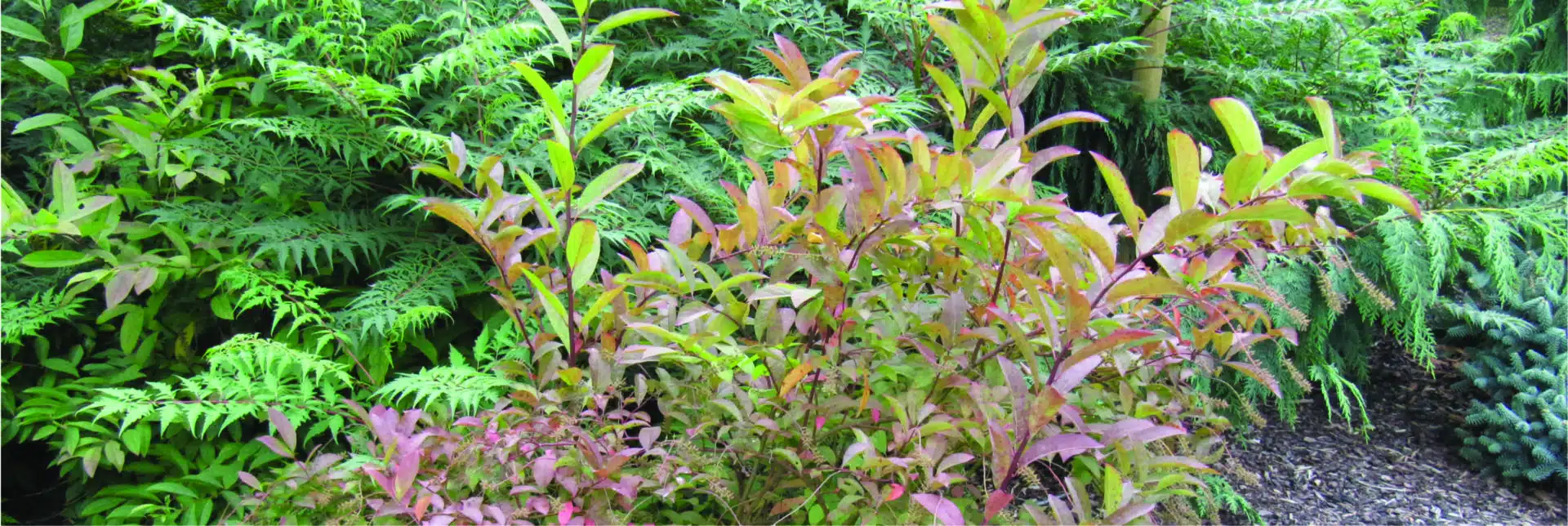Plants
Virginia sweetspire
Itea virginica ‘Henry’s Garnet’

Belonging to the family Iteaceae, the genus Itea contains 29 species, 28 of which are native to Asia and Africa. Itea virginica grows naturally only in wetlands from New Jersey, west to Missouri and south to Texas and Florida. Itea virginica ‘Henry’s Garnet’ was cultivated at the Henry Foundation in Gladwyne, Pennsylvania and was named by Judy Zuk of the nearby Scott Arboretum of Swarthmore College. Collected in 1954 in Georgia by Mary G. Henry, who selected it for its superior floral display and outstanding fall foliage, Itea virginica ‘Henry’s Garnet’ was first introduced to the trade in 1985 by Woodlanders, a mail order native plant nursery in South Carolina. Most Virginia sweetspire of southern provenance have not proven winter hardy in Northeast Ohio. ‘Henry’s Garnet’ is hardy to -20°F and has remained unscathed by most Northeast Ohio winters.
At The Holden Arboretum, mass plantings of Itea virginica ‘Henry’s Garnet’ may be seen on the west side of the Eliot and Linda Paine Rhododendron Discovery Garden and by Lantern Court’s parking lot. It has also been planted on an experimental basis in one of the bio-retention basins by the Corning Visitor Center parking lot.
The white flowers of ‘Henry’s Garnet’ Virginia sweetspire emit a lovely, yet fairly light, fragrance for two to three weeks in June, sometimes lasting into early July. Famous horticulturist, Michael Dirr, noted that when this plant is grown in full sun in moist rich soil, its flowers are “slightly short of spectacular,” and when planted in large groupings “the effect is staggeringly beautiful.” The fall foliage is another significant ornamental attribute. At the Arboretum, it has started as early as September displaying shades of red with purple highlights. The peak fall foliage occurs throughout most of October, and in early November the red, orange, and yellow shades of the inner leaves that are latest to fall are still showy. In years such as 2001 and 2007, when winter was late in coming, a few colorful leaves even hung on through Thanksgiving. Don’t expect this plant to leaf out early in spring. This characteristic is common to a number of other southern wetland species such as Taxodium distichum (bald-cypress), and Quercus lyrata (overcup oak). Leafing out late serves to avoid most late killing frosts. ‘Henry’s Garnet’ also has handsome foliage that is less susceptible to leaf spot than the average Itea virginica.
Another selection, ‘Little Henry’, was made by Richard Feist of Burlington at Kentucky’s Hummingbird Nursery. ‘Little Henry’, discovered as a branch sport of Itea virginica ‘Meadowlark’, was granted a plant patent in 1999, and introduced to the trade by Spring Meadow Nursery of Grand Rapids, Michigan as one of its Proven Winners®. This clone is more compact than ‘Henry’s Garnet’ and a little shorter, by about a foot. A mass planting may be found on the west side of the Paine Rhododendron Discovery Garden where it was 3’ tall in September 2013 after being planted in April. Another grouping of ‘Little Henry’ was planted in the Helen S. Layer Rhododendron Garden west of Sherwin Pond this past September.
A word of caution about new plant introductions. New does not always mean better. Come by and judge ‘Little Henry’ for yourself if you are considering buying this plant for your own garden. It is located adjacent to ‘Henry’s Garnet’ in the Paine Rhododendron Discovery Garden for comparison. Dirr has reported disease (leaf spot) and insect (flea beetle) problems with ‘Little Henry’ in USDA Zone 7.
Itea virginica ‘Henry’s Garnet’ received the Pennsylvania Horticultural Society Gold Medal in 1988, and it has performed admirably for more than 20 years at the Arboretum. In 1993 I purchased Itea virginica from The Holden Arboretum Plant Sale. It was sited in my garden in Eastlake on an old compost pile and grew 7’ tall next to a patch of bottlebrush buckeye (Aesculus parviflora), which served as a screen to a neighbor’s yard. After 22 years the single plant from a one gallon container has spread eight feet by underground stems (stolons).
Itea virginica performs best in full sun to part shade, and although it can grow in full shade, its density, flowering and fall foliage will all be diminished. It does well in a wide range of soil types, especially if mulched and kept moist during drought. It transplants readily and has no serious disease or insect pests. Although Virginia sweetspire is listed in the literature as salt tolerant, a large mass planted in 1964 between the first two parking bays in the Corning Visitor Center parking lot had to be removed in 2008 due to salt damage. It also cannot abide high pH soils.
Itea virginica and its cultivars all spread by stolons and form a thicket in time. In the landscape it is useful for naturalizing along watercourses and in seasonally wet heavy soil. It is useful in a border, as a screen, hedge, and also as a foundation planting. Flower buds form on old growth, so prune immediately after flowering removing the oldest (5-7 yr.) stems to ensure maximum floral display. Good woody companion plants for moist soils include Betula nigra (river birch), Clethra alnifolia (summersweet), Ilex verticillata (winterberry), and Leucothoe axillaris (coast leucothoe).




